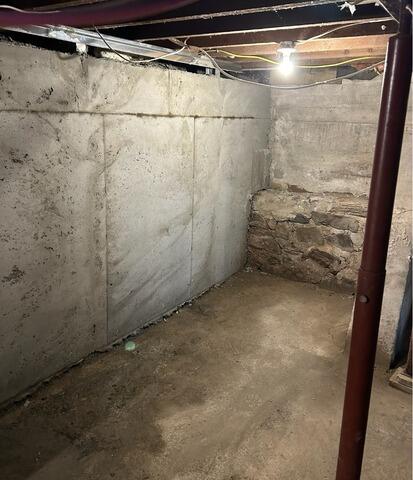Before & After Photos
Click on a photo to enlarge.
StableLock Wall Helps Mattawamkeag Municipal Building
The Board of Selectmen for the Mattawamkeag Municipal Building reached out to TC Hafford Basement Systems for help with their failing foundation. The walls were eroding, showing cracks, crumbling, and even gaping holes. We installed StableLock Wall system to prevent any further shifting of the failing wall. StableLock Wall is a poured concrete wall that is poured against the original wall to provide added support and stability. It leaves a nice, smooth finished look when the project is complete. Traditional methods of foundation repair often involve lifting the structure which is an intensive process, as well as very costly. StableLock Wall provides a cost-effective solution without the disruption of lifting.
Moving Foundation Wall Stopped with PowerBrace
After recently moving into this Corea, ME, home, the homeowner noticed the back wall in their basement developed a crack and started to move. The homeowner purchased this home with the intention of this being their forever home, so they didn’t want to waste time fixing the problem. The homeowner submitted a request for a free estimate online, and System Design Specialist Craig Ziegenbein worked with the homeowner to design a structural system that would stabilize the basement wall. PowerBraces were installed to permanently stabilize the wall and prevent any further movement. With PowerBraces, the bottom bracket is secured to the concrete floor, and the top bracket is anchored to the floor joist. Once installed, the PowerBraces are tightened, which generates positive pressure on the supported wall. Now that the wall is stabilized, the homeowner can enjoy their new home without having to worry about any structural issues causing them problems.
Bowing Walls in Houlton, ME
Houlton, ME homeowners were concerned about their old foundation rock walls that were bowing and crumbling, so they reached out to TC Hafford Basement Systems for help. After giving a free estimate we established a plan to install a new StableLock Wall. StableLock Wall system helps protect failing foundation walls by pouring a new concrete wall in front of the original wall. Rather than traditional lifting of the home, which is expensive, we can pour a new wall with little disruption to the homeowners.
Energy Saving Crawl Space
Heating a home during the winter can be expensive, and if you have an open crawl space, you're virtually burning money. A crawl space without insulation leads to cold air coming in through your foundation during the winter and hot air warming your home during the summer. Looking to save money on their energy bill and protect the health of their home year-round, this York, ME, homeowner called Dr. Energy Saver by TC Hafford Basement Systems for a free estimate.
System Design Specialist Nima Farshid worked with the homeowner to test how energy-efficient their home is with a Blower Door Test. A Blower Door Test measures how much air leaks in or out of a building, helping the homeowner and Nima have a better understanding of what needs to be done to the home. Encapsulating the crawl space was the first step in the plan, so CleanSpace with Drainage Matting was laid down, creating an inorganic seal between the crawl space and the earth. Vent Covers were installed to close off vents that would otherwise let outside air flow right into the crawl space. SprayFoam was installed on the walls and rim joists to insulate the crawl space. SprayFoam is a closed-cell foam that is not only a thermal barrier but also a powerful moisture barrier since it does not absorb water.
With the crawl space encapsulated with CleanSpace and sealed with SprayFoam, the homeowner now owns a more energy-efficient home that is healthier, and they no longer have to deal with cold floors in the winter and a humid crawl space during the summer.
Crawl Space with Bad Insulation Leading to Cold Floors
This Cape Neddick, ME, homeowner had been dealing with cold floors due to an uninsulated crawl space. Wanting to save money on their energy bills and make their home more energy efficient, the homeowner called TC Hafford Basement Systems for a free estimate. Dr. Energy Saver System Design Specialist Josh Hamel met with the homeowner to work with them to design an energy-saving system for their home. Closed cell SprayFoam was installed along the rim joists and on the walls to insulate the crawl space. Cold air is kept out and warm air in, keeping the homeowners floors warmer in the winter without the need to spend money keeping the heat on in their home higher than it needs to be.










